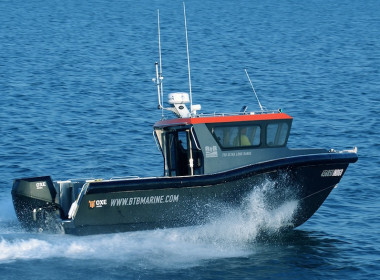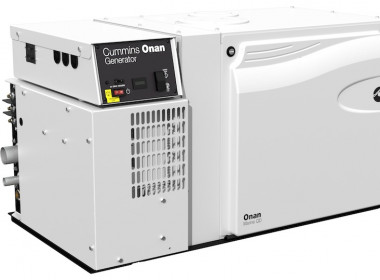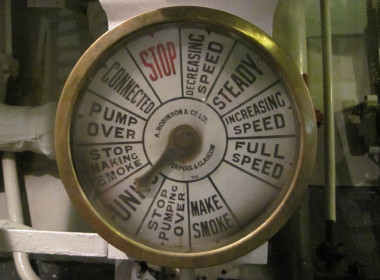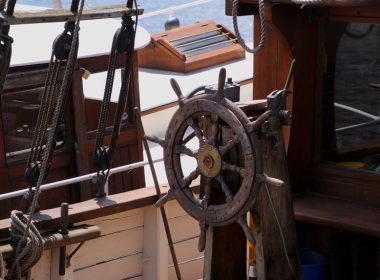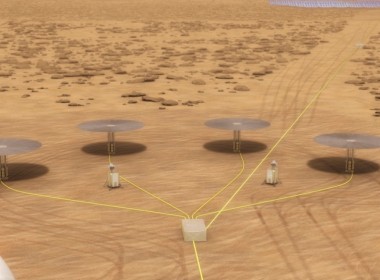COLUMN | The Voice (or “Ask a sailor”) [An Innocent Australian]

“I found you in the Yellow Pages,” said the Englishman who was on the other end of the phone. “This advert tells me that you are clever with marine designs and surveys?”
“I am not so sure we’re clever, but yes, that’s what we do,” I replied. “How can I help?”
“I am the boss of the Aboriginal and Torres Strait Islanders Community – ATSIC, and one of our communities has bought a landing barge that they were assured would carry a semi-trailer at twenty knots. Anyway, when it arrived, we put a Land Cruiser on it and it fell through the deck. Can you come and look at it for us, please?”
I duly caught a flight to Darwin, met the English manager of ATSIC, and we flew to remote Croker Island in Arnhem Land to view the wounded vessel. This was 1985.
The community had listened to a fast-talking kiwi salesman who verbally promised the earth of this barge and that it would indeed transport a semi-trailer full of groceries from Darwin to the community. This diminutive 22-metre, lightweight aluminium landing craft had as much chance of carrying a semi-trailer as I had of flying with the aid of Paddington Bear welly boots. But there were no warranties, no checks or balances, and they had bought a lemon. We did manage to get total reparation for ATSIC and they were happy with what we did and how we did it.
This was the start of a long association with ATSIC, the English gentleman, and the Commonwealth Development Corporation (CDC), which was in charge of investments on behalf of the Aboriginal communities Australia-wide. If it was for any marine activity or investment, our company was consulted and did so for projects in NT, FNQ, the Torres Strait, NSW, and SA.
I met a variety of nice people along the way, Gatjil Djerrkura, Lowitja (Lois) o’ Donohue, Senator Neville Bonnor and his red-headed wife Heather of Scottish descent, and some outstanding community leaders, certainly not all. The team at CDC in Canberra were exceptional and diligent.
We helped the Mawa group near Borroloola in the NT to structure shareholding in the Bing Bong Transshipment vessel Aburri and in turn obtain a steady source of training and jobs. This vessel is now in it’s 32nd year of exporting lead zinc and has been a success story.
“We may have been kind but certainly not crazy.”
As requested, we called tenders for the establishment of the Palm Island Barge service. This service would give the 3,000 residents of Palm Island a regular ferry service for passengers, cars, and trucks, which they didn’t have, and saw them having to fork out for an expensive airfare just to go to the dentist or to see a specialist.
There was not one submission for this tender, so my wife, a compassionate soul, suggested that we be the joint venture partner. “The community and particularly the children, deserve a good ferry service,” she said.
We hung in for four years as partners with Palm Island Community until their own freight contract tender came up. To our total surprise and disappointment, they gave it to an outside barge company, because “They gave us footy jumpers” the week before the tender. Go figure!
We immediately went to CDC in Canberra and surrendered our interest in the venture. We may have been kind but certainly not crazy.
Shortly afterwards, yet another new peak body in Aboriginal affairs recognised that the English gentleman CEO of CDC was in fact not black and he was ushered out the door despite an impeccable 25-year track record, and CDC was renamed Indigenous Business Australia (IBA).
We tried several times to get the state and federal governments to provide a proper Ro-Pax ferry service through the Outer Torres Strait as there are four to five deaths by tinnie in the region annually, not to mention Australia’s largest border incursions. It is the country’s only region of island communities that doesn’t have a commuter service and the lack of a ferry service is an indictment on the last three decades of governments.
We also tried several times with incumbent leaders in Cape York to assist them in acquiring marina facilities, as there are none such facilities between Port Douglas and Darwin, yet there is a huge market potential for domestic cruising vessels including me and my boat. The indigenous youth are naturals with boats and fishing, so such a strategy creates a great training ground for regional indigenous communities.
“Come away from your coffee club and spend at least three months in and around a variety of aboriginal communities to get their opinion of what they need.”
My visit to Doomadgee two years ago was a telling story. A Christian group established the community in the 1930s and built schools, dormitories, and a hospital. The community had their own market garden, their own concrete batching plant, etc. The youth were housed in separate dormitories and the boys were sent off at 14 to be trained as stockmen whilst the girls went into nursing.
There was full employment until the 1980s when “self-determination’ was passed and the mission administration was closed. The unemployment rate, according to my aboriginal host, is now well over 60 per cent and not as ABSTATS reported it. Certainly, the court house looked very busy that day and youth opportunities looked bleak.
Alas, my coal face history with indigenous groups and my personal campaigns, including many proposals (confirmed in numerous Baird Maritime columns), have been marred, stalled, and obstructed by inter-tribal offences, local personality disputes, and opposing indigenous grant programs, of which there are reportedly over 42. To a simple sailor like me, the “Aboriginal Industry” is a huge multi-pronged bureaucracy based in the capital cities well away from communities. The industry has hundreds, possibly thousands, of snouts in the trough and continues to be less than optimum, and it is in need of urgent fixing.
To even suggest we form yet another layer of bureaucrats under a grand title of The Voice and embed it into the constitution is the collective and dangerous thought-bubble of madmen.
For anyone considering the “yes” vote, come away from your coffee club in Tewantin, Ultimo, or wherever and spend at least three months in and around a variety of aboriginal communities to get their opinion of what they need. You’ll find it’s certainly not more bureaucrats.


